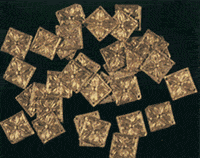 |
APPLIQUES,
or bracteates, thin gold plaques perforated at the edge with holes
for attachment are common in sumptuary arts of the ancient Near
East. Some are squares with embossed decoration, like nos. 116-119,
some are a jour forms, like no. 186. They were sewn to garments,
headgear and equipment of textile and leather, as is particularly
well documented by assemblages recovered from Scythian and related
graves of south Russia (where they were used on garments of both
sexes). The Scythians may have adopted the custom during their
incursions into the Near East in the 7th century BC. The use
of gold appliques on costume during the Achaemenid period is particularly
well documented in classical texts and from the archaeological
evidence. Appliques of Achaemenid type have been recovered at
Sardis, from five graves of the city cemetery and one at Bin Tepe
(limestone sarcophagus burial at Kenderlik Koyu which yielded
a jour appliques in forms of rosettes, lotus flower and bud chain,
and one lamassu). A jour rosette appliques have been recovered
in two cremation burials (F and I) at Gordion.
APPLIQUES are also depicted in representational art. Tunics
with richly decorated motifs appear on royal figures in Assyrian
reliefs of the 9th century BC. An Urartian
gold medallion from Toprakkale, dated to 600 BC, shows two figures
wearing garments with decorated surface. An ivory figurine from
Ephesos of a female holding spindle and distaff is decorated in
front and back with a checker pattern framed by ladder bands which
form squares; the pattern of the fabric looks convincing as a
woven design or as a garment decorated with appliques. Another
ivory figurine from Ephesos, supporting a pole crowned by a hawk
and carrying a bowl and a pitcher, wears a tunic which is incised
with small diamond shapes, representing appliqued or embroidered
decoration. The garment of the so-called "Eunuch Priest"
from Ephesos is also decorated at front and back with engraved
patterns such as spiral-armed crosses and cross - hatched lozenges.
For west Anatolian fashions of the late 7th century BC these ivories
are the most realistic renderings. Richly decorated chi tons are
also represented on Melian amphorai of the 7th century BC.
|









